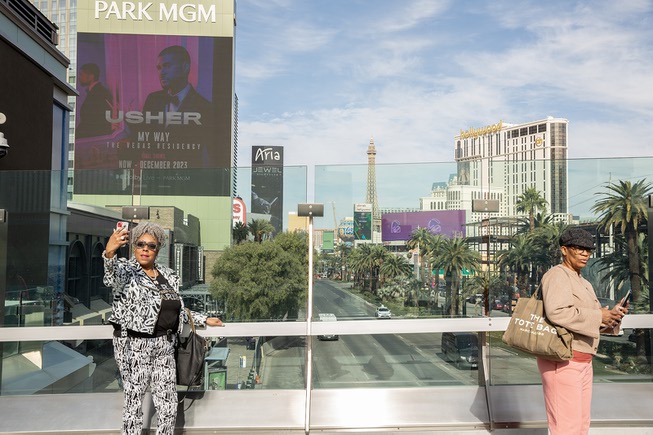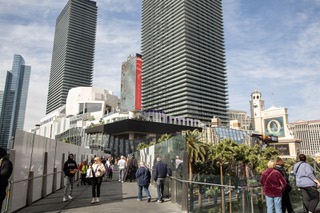
A woman stops to take a selfie on a pedestrians bridge at Las Vegas Blvd. and Park Ave. Wednesday Nov. 29, 2023.
Wednesday, Jan. 3, 2024 | 2 a.m.
Those visitors to the Resort Corridor looking to take a photo for their social media feed or scrapbook won’t be permitted to do so on pedestrian bridges along the Las Vegas Strip, the Clark County Commission determined Tuesday.
Commissioners, on an unanimous 7-0 vote, passed an ordinance banning pedestrians from stopping, standing or engaging in activities that would cause others to stop on pedestrian bridges.
Offenders would face fines of up to $1,000, or six months in jail.
It comes almost two months after the Las Vegas Grand Prix — where pedestrians crowded on bridges to catch a glimpse of the event — and only six weeks before the Super Bowl in February, which is set to draw hundreds of thousands of people for those events.
“When you get right down to it, the unique nature of these bridges and unique nature of this city and the unique nature of Las Vegas Boulevard, when there can be 100,000 people moving up and down the street at the same time and accessing the bridges and moving along as they do, that becomes really important,” Commissioner Jim Gibson said.
“It’s essential for us that we provide the tools to the police department to be able to do what needs to be done in the rare occasion that someone is going to object or someone is going to refuse to abide by an ordinance that is a lawful ordinance, that makes all the sense in the world (and) that has its objective to keep every pedestrian moving along around those bridges, up and down those elevators safe,” he said.
The ordinance will create “pedestrian flow zones” on the overpasses and up to 20 feet surrounding connecting stairs or escalators that would make stopping, standing or doing anything to cause another person to stop or stand in the zone a violation, according to the text of the ordinance.
County counsel noted that an exception is included in the ordinance for people who have to stop while waiting to use stairs or escalators near the bridges.
Lisa Logsdon, counsel for Clark County and lead of the civil division in the county district attorney’s office, also noted that the ordinance’s language, after working with the Culinary Union, was clarified to specify that any unintended stoppage on the bridges due to picketing activity on the street-level sidewalk would not be in violation of the ordinance.
William Sousa, a professor in UNLV’s department of criminal justice who prepared a study looking at crime on the bridges, found that calls for law enforcement services on Las Vegas Boulevard increased 29% from 37,589 in 2018 to 48,358 in 2022. He used data from Las Vegas Metro’s research and analysis unit.
And while pedestrian bridges account for less than 6% of the total length of the sidewalk system in the Resort Corridor, about 11% of what he termed “disorder” calls occurred on the elevated walkways. “Disorderly offenses” include fights, public intoxication, public drug use and suspicious persons, Sousa said.
Sousa concluded that “calls for disorderly offenses on Las Vegas Boulevard are disproportionately concentrated on pedestrian bridges.”
This alleged high level of crime can affect people’s perceptions of safety while on the pedestrian bridges and lead to even more crime, Sousa said.
The narrowness of the bridges and limited entry or exit points also make them susceptible to causing crowd crush — when people become so packed into one area that they can suffer injuries or even die.
“When the nature of an environment is such that there are limited points of entry and exit, efforts should be made to facilitate the orderly move of people and make the flow of traffic as efficient as possible,” Sousa said. “An ordinance that prohibits stopping would provide a mechanism to manage the orderly movement of people on the bridges; this would make the bridges safer for everyone to use.”
Stoppage on pedestrian bridges not only can create problems for pedestrians, but law enforcement as well, Metro Undersheriff Andrew Walsh told the commission.
While the bridges are equipped with a “robust” system of cameras and have a team of officers conducting foot patrols on them, Walsh said it was difficult for officers to see what was happening on the bridges from the sidewalks below.
He also explained that — in the chance of a threatening situation such as an active shooter — people congregating on the bridges can create “an exceptional public safety issue” by impeding the casino exits or the bridge entrances for officers or people fleeing the danger.
That could add to the risk of a crowd crush occurring, Walsh noted.
“We’ve been very lucky so far that we have not had a crowd crush-type incident on those bridges where people were injured, but the old saying ‘Where it’s predictable, it’s preventable’ is staring us right in the face.”
Pedestrians violating the ordinance will first be informed of the law by Metro officers “in an attempt to generate voluntary compliance with the law,” then be issued a warning and asked to continue moving. If they refuse, Walsh said officers can issue a citation or make an arrest.
Virginia Valentine, CEO of the Nevada Resort Association, voiced support for the ordinance and said resorts were interested in keeping the bridges safe because they’re the only way pedestrians can safely cross the boulevard. She believes the ordinance will not only reduce injury on the bridges, but “increase the effective capacity of the bridges by reducing obstructions.”
“Visitation to the Strip has increased and large events have grown in size and number,” Valentine said minutes before the ordinance was passed. “Today, you have an opportunity to proactively improve the safety of the pedestrian bridges for guests and employees.”
The American Civil Liberties Union (ACLU) of Nevada submitted a letter in opposition with other groups including Progressive Leadership Alliance of Nevada, NAACP Las Vegas, Nevada Partnership for Homeless Youth, Nevada NOW, Nevada Homeless Alliance, Make the Road Nevada, Clark County Black Caucus and Service Employees International Union Local 1107.
Athar Haseebullah, executive director of ACLU of Nevada, told the commission his group would litigate the ordinance on First Amendment grounds, which the county argues is incidental. He also explained that the crime research is not specific enough and will now only rise with the county deciding “to criminalize the mere act of stopping.”
Eve Hanan, who leads the Thomas & Mack Legal Clinic’s Misdemeanor Clinic, said the new law — with its current language — would criminalize people who stop to take pictures or help others with directions. She criticized the law’s vague language and said it would be “impossible for an ordinary person to know when they’re in compliance with the law.”
Hanan said the ordinance allowed Metro “selective prosecution,” or the ability to choose specific groups on which to enforce the law.
“It’s a law not meant for equal enforcement,” Hanan said. “Stopping, standing, the intent to cause someone else to stop or stand — this is simply too vague, and the elevator exception doesn’t cure it.”
Commissioners Tick Segerblom and William McCurdy requested that Metro keep a database of the violations reported to ensure officers were not targeting any specific group while enforcing the law.
“This is a work in progress, so we really need to monitor this,” Segerblom said. “The lifeblood of the Strip is these walkways. We wouldn’t be here unless there was a need for it, but we also need to make sure that we don’t overcorrect something.”
The county will put signage along the pedestrian bridges and near stairs or escalators that will inform pedestrians when they enter the “flow zone.”
[email protected] / 702-948-7854 / @gracedarocha

